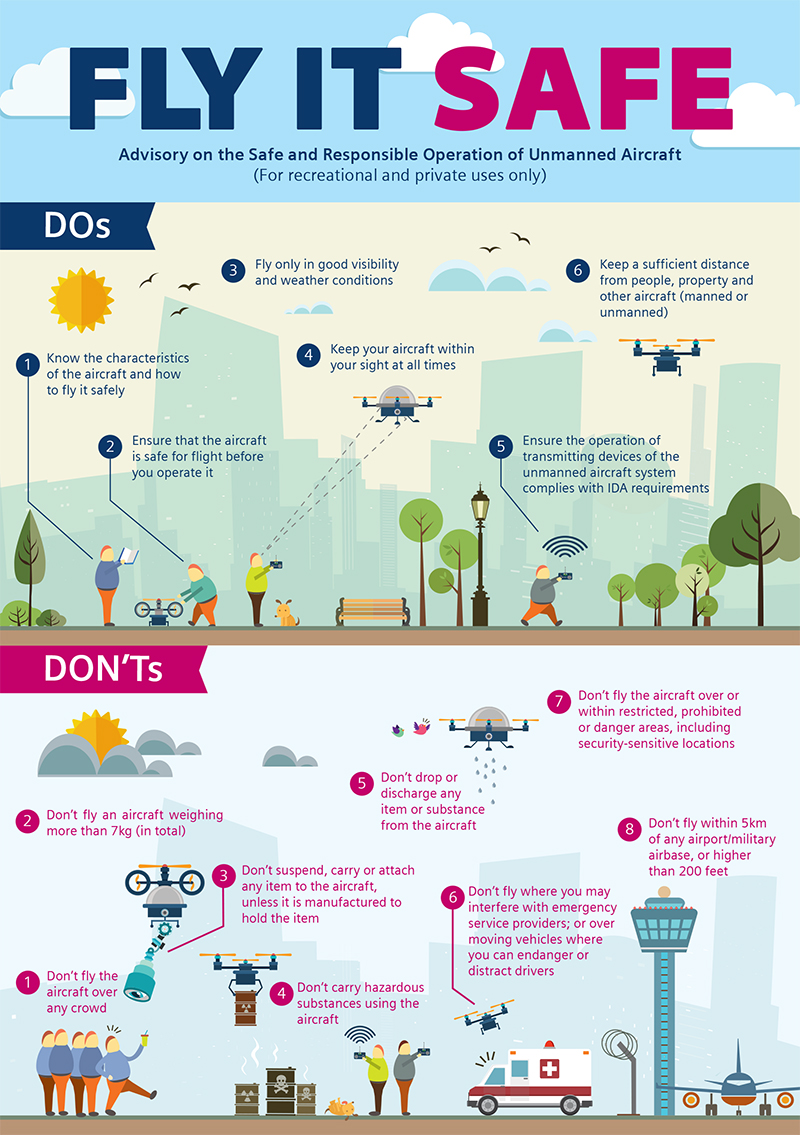In Singapore’s urban environment, there are not many places where a beginner can learn how to fly their drone without being concerned that the drone may crash into a building or stray across a congested road. In June 2015, to deal with an increase in the use of drones, the Civil Aviation Authority of Singapore (CAAS) released updated regulations for aerial activities with an emphasis on drone flying. Here is a summary of the rules for recreational flying:
No flying within 5km of any airport/military airbase
In areas close to airports and airbases, planes are flying at very low altitudes during takeoff and landing. The safety buffer radius of 5km is set to reduce the chances of a flyaway drone drifting into the path of a plane carrying passengers.
No flying of drones above 60m (200ft)
Fly drones below 60m to avoid interfering with other air traffic such as low-flying aircraft. This number refers to altitude above mean sea level and not to flight height: if your drone takes off from a hilltop 40m above sea level, it should not be flying more than 20m above its takeoff point!
No flying of any drone that weighs more than 7kg
The heavier your drone, the more damage it can do if it were to crash. Always stay within this weight limit or fly a lighter drone.
No discharging of any item of substance from your drone and/or carrying or any item that the drone was not manufactured to hold
Do not endanger people. Things can fall off your drone especially if the drone was not manufactured to carry that item. Always keep a safe distance away and avoid flying over people or property as much as possible.
All transmitting devices must comply with IMDA requirements
Most consumer/hobbyist drones purchased in Singapore are by default compliant with requirements set by the Info-communications Media Development Authority of Singapore (IMDA). If you intend to build your own drone, make sure you adhere with these transmission requirements.
Keep the drone within visual line-of-sight at all times
Currently, all drones flights must be carried out within visual line-of-sight (VLOS). Piloting a drone using video feed from your First-Person View (FPV) goggles is not sufficient to be considered as flying the drone within VLOS. It is important to have a proper flight path planned in advance so that you can decide ahead of time where the pilot should be positioned in order to maintain VLOS to the drone at all times.
If you intend to fly your drone outside of these recreational rules, you are required to apply for a permit with CAAS. It is also advisable to bring a friend with you for your first few flights; they can help you out with tasks or remind you of good safety practices while you’re busy keeping your eyes on the drone. If you are unsure of whether the location you intend to fly in is part of a restricted zone or near an airport or airbase, use the Garuda Plex Map to plan your flight before you head out.
To receive notifications of our future blog posts, follow us on Facebook and Twitter.
In Singapore’s urban environment, there are not many places where a beginner can learn how to fly their drone without being concerned that the drone may crash into a building or stray across a congested road. In June 2015, to deal with an increase in the use of drones, the Civil Aviation Authority of Singapore (CAAS) released updated regulations for aerial activities with an emphasis on drone flying. Here is a summary of the rules for recreational flying:
No flying within 5km of any airport/military airbase
In areas close to airports and airbases, planes are flying at very low altitudes during takeoff and landing. The safety buffer radius of 5km is set to reduce the chances of a flyaway drone drifting into the path of a plane carrying passengers.
No flying of drones above 60m (200ft)
Fly drones below 60m to avoid interfering with other air traffic such as low-flying aircraft. This number refers to altitude above mean sea level and not to flight height: if your drone takes off from a hilltop 40m above sea level, it should not be flying more than 20m above its takeoff point!
No flying of any drone that weighs more than 7kg
The heavier your drone, the more damage it can do if it were to crash. Always stay within this weight limit or fly a lighter drone.
No discharging of any item of substance from your drone and/or carrying or any item that the drone was not manufactured to hold
Do not endanger people. Things can fall off your drone especially if the drone was not manufactured to carry that item. Always keep a safe distance away and avoid flying over people or property as much as possible.
All transmitting devices must comply with IMDA requirements
Most consumer/hobbyist drones purchased in Singapore are by default compliant with requirements set by the Info-communications Media Development Authority of Singapore (IMDA). If you intend to build your own drone, make sure you adhere with these transmission requirements.
Keep the drone within visual line-of-sight at all times
Currently, all drones flights must be carried out within visual line-of-sight (VLOS). Piloting a drone using video feed from your First-Person View (FPV) goggles is not sufficient to be considered as flying the drone within VLOS. It is important to have a proper flight path planned in advance so that you can decide ahead of time where the pilot should be positioned in order to maintain VLOS to the drone at all times.
If you intend to fly your drone outside of these recreational rules, you are required to apply for a permit with CAAS. It is also advisable to bring a friend with you for your first few flights; they can help you out with tasks or remind you of good safety practices while you’re busy keeping your eyes on the drone. If you are unsure of whether the location you intend to fly in is part of a restricted zone or near an airport or airbase, use the Garuda Plex Map to plan your flight before you head out.
To receive notifications of our future blog posts, follow us on Facebook and Twitter.

